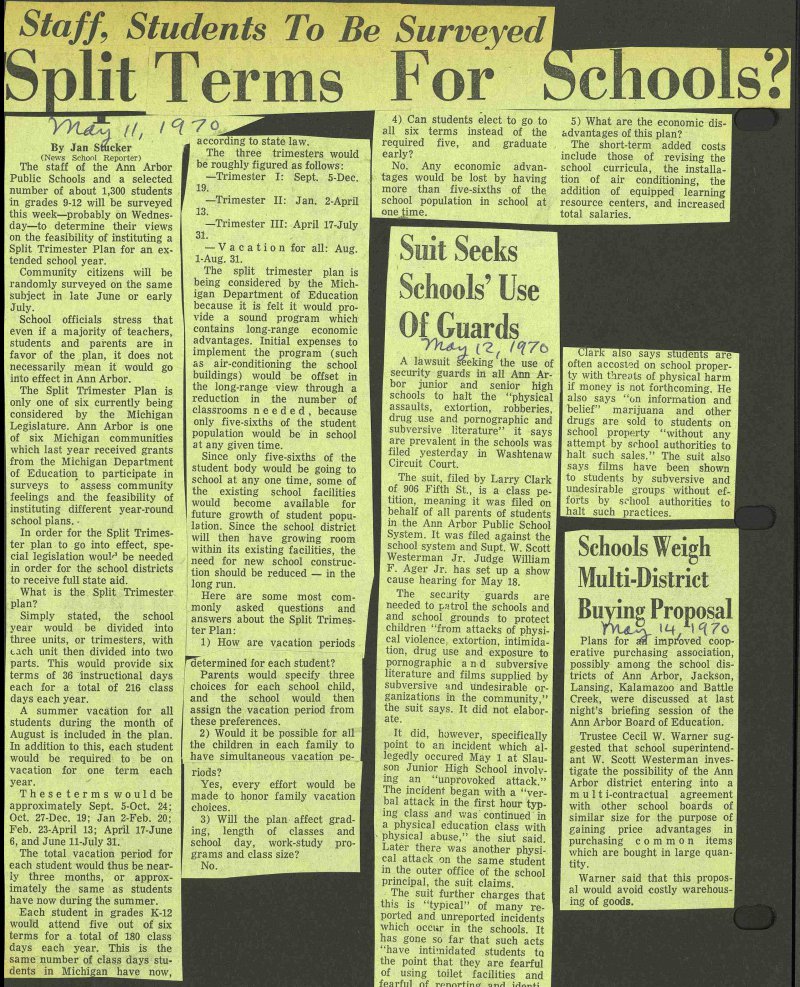Split Terms For Schools?

The staff of the Ann Arbor Public Schools and a selected number of about 1,300 students ïn grades 9-12 will be surveyed this week- probably on Wednesday- to determine their views on the feasibility of instituting a Split Trimester Plan for an extended school year. Community citizens will be randomly surveyed on the same subject in late June or early July. School officials stress that even if a majority of' teachers, students and parents are in favor of the plan, it does not necessarily mean it would go into effect in Ann Arbor. The Split Trimester Plan is only one of six currently being considered by the Michigan Legislature. Ann Arbor is one of six Michigan communities which last year received grants f rom the Michigan Department of Education to particípate in surveys to assess community feelings and the feasibility of instituting different year-round school plans. - In order for the Split Trimester plan to go into effect, special legislation woul be needed in order for the school districts to receive full state aid. What is the Split Trimester plan? Simply stated, the school year would be divided into three units, or trimesters, with tach unit then divided into two parts. This would provide six terms of 36 instructional days each for a total of 216 class days each year. A summer vacation for all students during the month of August is included in the plan. In addition to this, each student would be required to be on vacation for one term each year. Theseterms would be approximately Sept. 5-Oct. 24; Oct. 27-Dec. 19; Jan 2-Feb. 20; Feb. April 13; April June 6, and June 11-July 31. The total vacation period for each student would thus be nearly three months, or approximately the same as students have now during the summer. Each student in grades K-12 would attend five out of six terms for a total of 180 class days each year. This is the same number of class days students in Michigan have now. according to state law. The three trimesters would be roughly figured as follows: -Trimester I: Sept. 5-Dec. 19. -Trimester II: Jan. 2-April 13. -Trimester III: April 17-July 31. - Vacation for all: Aug. 1-Aug. 31. The split trimester plan is being considered by the Michigan Department of Education because it is feit it would provide a sound program which contains long-range economie advantages. Initial expenses to implement the program (such as air-conditioning the school buildings) would be offset in the long-range view through a reduction in the number of classrooms n e e d e d , because only five-sixths of the student population would be in school at any given time. Since only five-sixths of the student body would be going to school at any one time, some of the existing school facilities would become available for future growth of student population. Since the school district will then have growing room within its existing facilities, the need for new school construction should be reduced - in the long run. Here are some most commonly asked questions and answers about the Split Trimester Plan: 1) How are vacation periods "aétermined for each student? Parents would specify three ehoices for each school child, and the school would then assign the vacation period from these preferences. 2) Would it be possible for all I the children in each family to have simultaneous vacation I riods? i Yes, every effort would be made to honor family vacation ehoices. 3) Will the plan affect I ing, length of classes and I school day, work-study 1 grams and class size? No. 4) Can students elect to go to all six terms instead of the required five, and gradúate early? No. Any economie advantages would be lost by having more than five-sixths of the school population in school at ene time. 5) What are the economie disadvantages of this plan? The short-term added eosts include those of revising the school curricula, the installation of air conditioning, the addition of equipped learning I resource centers, and increased total salaries.